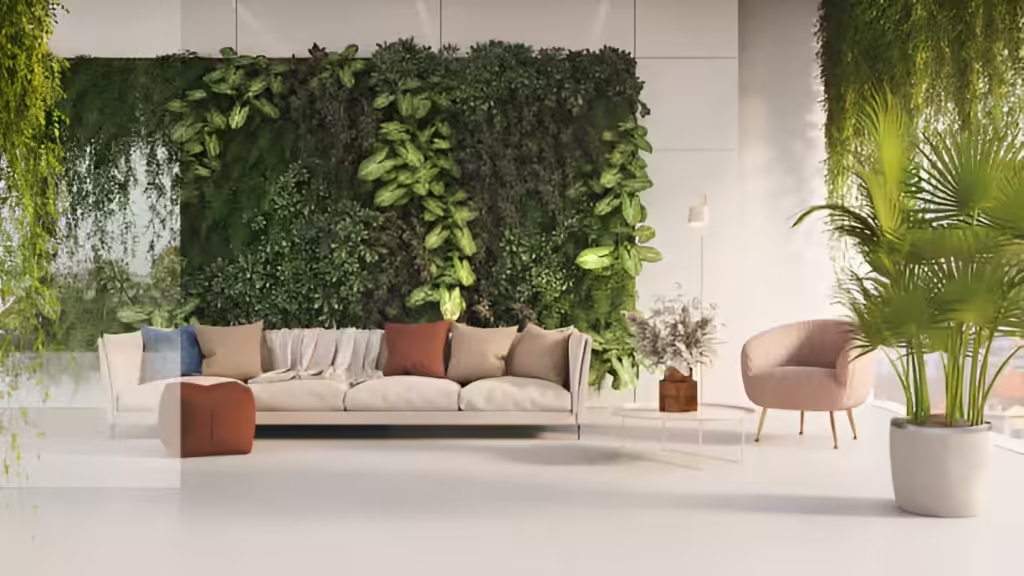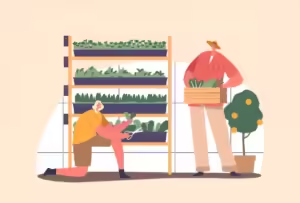In the hustle and bustle of modern life, finding ways to connect with nature can be challenging, especially for urban dwellers. Enter indoor gardening – a perfect solution that not only brings the outdoors in but also elevates your living space to new heights of beauty and tranquility. This article will explore the world of indoor gardening, offering insights into design concepts, plant selection, and maintenance tips that will transform your home into a lush oasis.
The Rise of Indoor Gardening
Indoor gardening has experienced a significant surge in popularity in recent years, and for good reason. As more people find themselves living in urban environments with limited access to outdoor spaces, the desire to incorporate nature into daily life has grown. Indoor gardens offer a myriad of benefits, from improving air quality and reducing stress to enhancing the aesthetic appeal of your home.
Types of Indoor Gardens
Before diving into specific designs, it’s essential to understand the various types of indoor gardens you can create. Each style has its unique charm and can be adapted to suit different spaces and preferences.
1. Windowsill Gardens
Perfect for those with limited space, windowsill gardens make use of the natural light streaming through your windows. These compact gardens are ideal for growing herbs, small flowering plants, or even some vegetables. With the right selection of plants, you can create a charming display that adds life to your windows while providing fresh herbs for your culinary adventures.
2. Vertical Gardens
Vertical gardens are a game-changer for those looking to maximize space and create a stunning visual impact. By utilizing wall space, you can cultivate a diverse array of plants without sacrificing floor area. Living walls, pocket planters, and tiered shelving systems are all excellent options for creating vertical gardens that serve as living art pieces in your home.
3. Terrariums
Terrariums are miniature ecosystems enclosed in glass containers, offering a low-maintenance way to bring greenery into your space. These self-contained gardens can range from small desk accessories to large statement pieces. With proper plant selection and care, terrariums can thrive for years, providing a fascinating glimpse into a miniature world.
4. Hanging Gardens
Hanging gardens add a whimsical touch to any room, drawing the eye upward and creating the illusion of more space. From macramé plant hangers to innovative upside-down planters, the options for hanging gardens are diverse and can suit various design aesthetics.
Plant Selection: Choosing the Right Green Companions
Selecting the right plants is crucial for the success of your indoor garden. Consider factors such as available light, humidity levels, and your ability to provide care when choosing plants. Here are some categories to consider:
Low-Light Plants
For rooms with limited natural light, opt for plants that thrive in low-light conditions. Some popular choices include:
- Snake Plant (Sansevieria)
- ZZ Plant (Zamioculcas zamiifolia)
- Pothos (Epipremnum aureum)
- Chinese Evergreen (Aglaonema)
These plants are not only tolerant of low light but are also known for their air-purifying qualities.
Air-Purifying Plants
Improve the air quality in your home by incorporating plants known for their air-purifying properties. NASA’s Clean Air Study identified several plants that effectively remove common indoor pollutants:
- Spider Plant (Chlorophytum comosum)
- Peace Lily (Spathiphyllum)
- Rubber Plant (Ficus elastica)
- Dracaena varieties
Edible Indoor Plants
For those looking to combine aesthetics with functionality, consider growing edible plants indoors. Herbs are particularly well-suited for indoor cultivation and can add fresh flavors to your cooking. Some options include:
- Basil
- Mint
- Chives
- Rosemary
- Thyme
You can also experiment with growing dwarf citrus trees, microgreens, or even small vegetable varieties like cherry tomatoes or compact peppers.
Design Elements: Creating a Cohesive Look
Elevating your space through indoor gardening involves more than just placing plants around your home. Consider these design elements to create a cohesive and visually appealing indoor garden:
Choosing the Right Containers
The pots and planters you choose play a significant role in your indoor garden’s overall aesthetic. Consider the following:
- Material: Choose from ceramic, terracotta, metal, or modern plastic options.
- Size: Ensure the container is appropriate for the plant’s size and growth potential.
- Style: Select containers that complement your existing decor.
- Drainage: Opt for pots with drainage holes or use cachepots to prevent water damage to surfaces.
Color Coordination
Create a harmonious look by coordinating the colors of your plants, pots, and surrounding decor. You might choose a monochromatic scheme with varying shades of green, or add pops of color with flowering plants and vibrant containers.
Mixing Textures and Sizes
Add visual interest to your indoor garden by combining plants with different textures and sizes. Pair large, smooth-leaved plants with feathery ferns or spiky succulents. Vary the heights of your plants to create depth and dimension in your displays.
Maintenance Tips: Keeping Your Indoor Garden Thriving
Proper care is essential for maintaining a healthy and beautiful indoor garden. Here are some key maintenance tips:
Watering and Fertilizing
Different plants have varying water requirements, so research the needs of each species in your collection. As a general rule:
- Allow the top inch of soil to dry out between waterings for most plants.
- Use room temperature water to avoid shocking the plants.
- Fertilize during the growing season (spring and summer) with a balanced, water-soluble fertilizer.
Proper Lighting
While many plants can adapt to indoor light conditions, it’s important to provide adequate light for optimal growth:
- Place high-light plants near south-facing windows.
- Use sheer curtains to filter intense direct sunlight.
- Consider supplementing with grow lights for plants in low-light areas.
Pest Control
Indoor plants can sometimes fall victim to pests. Regular inspection and prompt action can prevent infestations:
- Check plants weekly for signs of pests or disease.
- Use neem oil or insecticidal soap for common pests like spider mites or mealybugs.
- Isolate affected plants to prevent the spread of pests or diseases.
Creative Display Ideas
Take your indoor garden to the next level with these creative display ideas:
Living Walls
Transform a blank wall into a lush vertical garden using modular planting systems or DIY frame planters. Living walls make a dramatic statement and can significantly improve indoor air quality.
Floating Shelves
Install floating shelves at varying heights to create a dynamic plant display. This approach works well for collections of small plants or trailing varieties that can cascade over the edges.
Repurposed Furniture as Planters
Give new life to old furniture by repurposing items as unique planters. An old ladder can become a tiered plant stand, while a vintage dresser with the drawers removed can house a variety of plants.
Benefits of Indoor Gardening
Beyond aesthetics, indoor gardening offers numerous benefits that contribute to overall well-being:
Improved Air Quality
Plants naturally filter the air, removing toxins and increasing oxygen levels. This can lead to improved respiratory health and better sleep quality.
Stress Reduction
Caring for plants and being surrounded by nature has been shown to reduce stress levels and improve mood. The act of gardening itself can be a meditative and calming activity.
Enhanced Productivity and Creativity
Studies have shown that the presence of plants in work environments can increase productivity and creativity. Bring these benefits home by incorporating plants into your home office or creative spaces.
Connection with Nature
Indoor gardening provides a tangible connection to nature, which is especially valuable for those living in urban environments with limited access to green spaces.
Conclusion
Indoor gardening is more than just a trend; it’s a lifestyle choice that brings beauty, health benefits, and a sense of accomplishment to your living space. By carefully selecting plants, considering design elements, and providing proper care, you can create a thriving indoor garden that elevates your home and nurtures your well-being.
Whether you’re a seasoned plant enthusiast or a beginner with a budding interest, there’s an indoor gardening style that’s perfect for you. Start small, experiment with different plants and designs, and watch as your space transforms into a vibrant, living sanctuary. Remember, every plant you nurture is a step towards a greener, more beautiful home and a deeper connection with the natural world.
Embrace the world of indoor gardening, and let your creativity bloom alongside your plants. Your perfect indoor oasis awaits – it’s time to bring it to life!
For additional tips, explore our Ultimate Guide to Indoor Gardening








